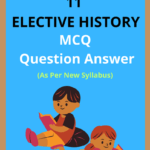Class 11 History MCQ Chapter 5 Changing Cultural Traditions Solutions to each chapter is provided in the list so that you can easily browse through different chapters Class 11 History MCQ Chapter 5 Changing Cultural Traditions Solutions and select need one. Class 11 History MCQ Chapter 5 Changing Cultural Traditions Question Answers Download PDF. AHSEC Elective History Multiple Choice Class 11 Solutions.
Class 11 History MCQ Chapter 5 Changing Cultural Traditions
Also, you can read the NCERT book online in these sections Solutions by Expert Teachers as per Central Board of Secondary Education (CBSE) Book guidelines. AHSEC Class 11 Elective History Objective Type Solutions are part of All Subject Solutions. Here we have given AHSEC Class 11 Elective History Multiple Choice Question and Answer, AHSEC Board Class 11 History Objective Type Solutions for All Chapters, You can practice these here.
Changing Cultural Traditions
Chapter: 5
| MCQ |
1. What term is commonly used to describe the blending of different cultural elements over time?
(a) Assimilation.
(b) Syncretism.
(c) Isolationism.
(d) Traditionalism.
Ans: (b) Syncretism.
2. Which era is known for the Renaissance, a period marked by a revival of interest in art, literature, and learning in Europe?
(a) Middle Ages.
(b) Renaissance.
(c) Industrial Revolution.
(d) Age of Exploration.
Ans: (b) Renaissance.
3. In Arabic, the person who was known as ‘Aflatun’ was
(a) Plato.
(b) Aristotle.
(c) Dante.
(d) Caesar.
Ans: (a) Plato.
4. Petrarch was given the title of ‘Poet Laureate’ in Rome in:
(a) 1341.
(b) 1342.
(c) 1343.
(d) 1344.
Ans: (a) 1341.
5. The painting ‘Mona Lisa’ was made by
(a) Leonardo da Vinci.
(b) Michelangelo.
(c) Raphael.
(d) Donatello.
Ans: (a) Leonardo da Vinci.
6. The author of the book ‘The Prince’ is
(a) Lorenzo Valla.
(b) Gutenberg.
(c) Machiavelli.
(d) Alberti.
Ans: (c) Machiavelli.
7. The earliest universities in the European continent were setup in the country of
(a) France.
(b) Germany.
(c) Italy.
(d) England.
Ans: (c) Italy.
8. The families that gave more importance to women during the 15th century were those of
(a) Aristocrats.
(b) Artists.
(c) Merchants.
(d) Scholars.
Ans: (c) Merchants.
9. The term ‘cultural imperialism’ is often used to describe the dominance of one culture over others through:
(a) Military conquest.
(b) Economic influence.
(c) Cultural influence.
(d) Political alliances.
Ans: (c) Cultural influence.
10. The term ‘cultural imperialism’ is often used to describe the dominance of one culture over others through:
(a) Military conquest.
(b) Economic influence.
(c) Cultural influence.
(d) Political alliances.
Ans: (c) Cultural influence.
11. By the early fifteenth century, ______ was used for those masters who taught grammar, poetry, rhetoric, history and moral philosophy.
(a) Literates.
(b) Humanists.
(c) Authors.
(d) Writers.
Ans: (b) Humanists.
12. When Renaissance occurred in Europe?
(a) 11th century.
(b) 13th century.
(c) 15th century.
(d) 16th century.
Ans: (c) 15th century.
13. Ptolemy’s Almagest was a work on ______.
(a) Mathematics.
(b) Astronomy.
(c) Philosophy.
(d) Sociology.
Ans: (b) Astronomy.
14. Ibn Rushd was an Arab philosopher of _____.
(a) France.
(b) Germany.
(c) Britain.
(d) Spain.
Ans: (d) Spain.
15. The spread of Islam into regions like South Asia and Southeast Asia led to the synthesis of local cultures with Islamic traditions, known as:
(a) Syncretism.
(b) Cultural isolation.
(c) Imperialism.
(d) Assimilation.
Ans: (a) Syncretism.

Hi! my Name is Parimal Roy. I have completed my Bachelor’s degree in Philosophy (B.A.) from Silapathar General College. Currently, I am working as an HR Manager at Dev Library. It is a website that provides study materials for students from Class 3 to 12, including SCERT and NCERT notes. It also offers resources for BA, B.Com, B.Sc, and Computer Science, along with postgraduate notes. Besides study materials, the website has novels, eBooks, health and finance articles, biographies, quotes, and more.


